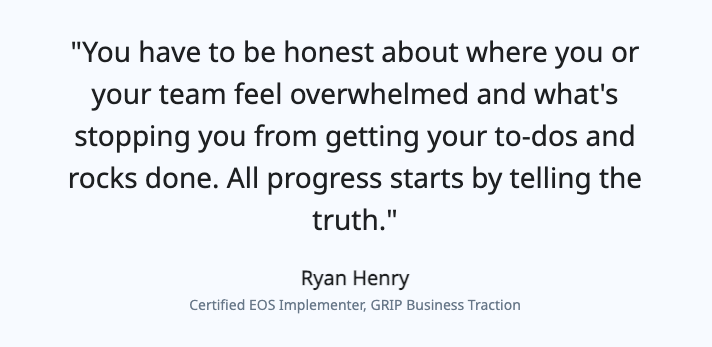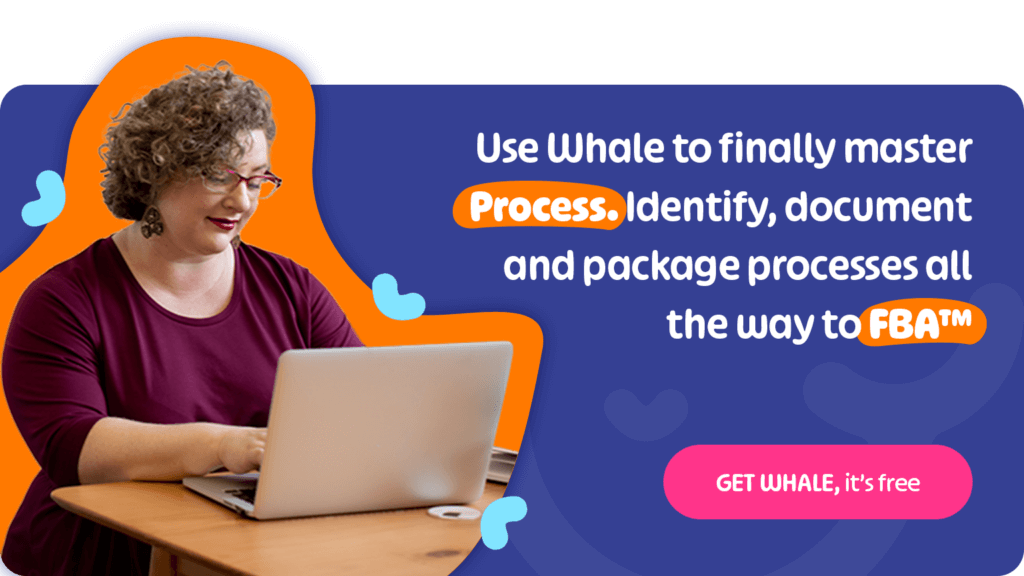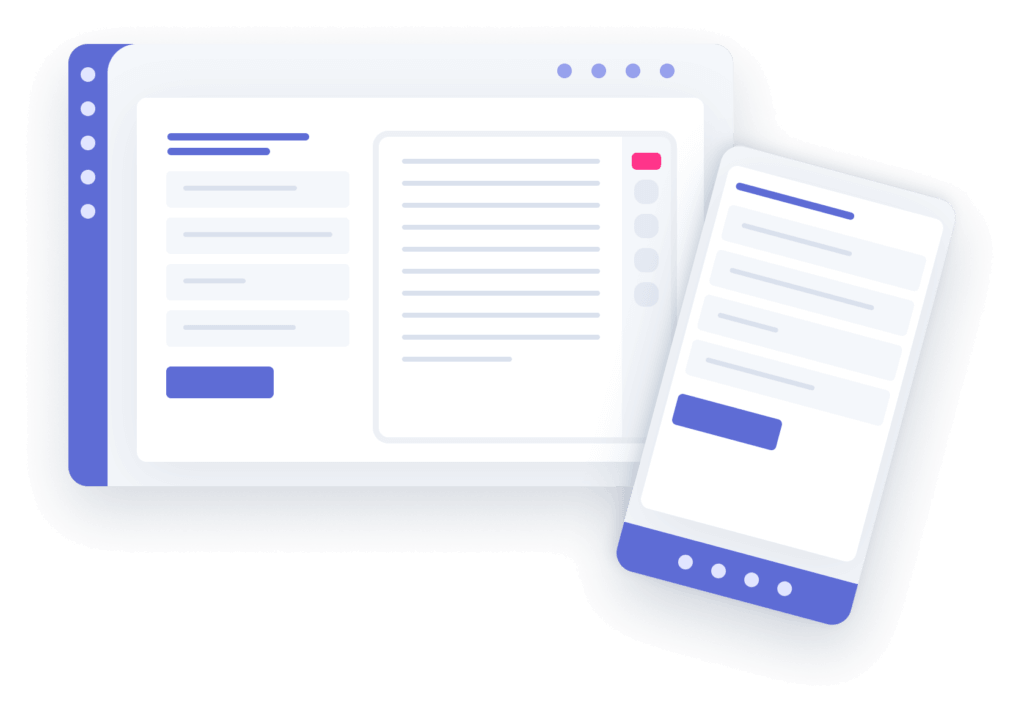Challenges at every turn? Welcome to IDS!
The biggest part of being an entrepreneur is the ability to solve problems and challenges!
One key component of EOS®, the Entrepreneurial Operating System® is ISSUES!
If you look up the definition for ‘issues’ in the dictionary, you’ll get something along the lines of:
“An important topic or problem for debate or discussion.”
Which is kinda funny, really. Because how often are company issues left undiscussed, unaired, and unresolved?
In reality: Daily.
The truth is, identifying, discussing, and solving issues can be hard work, time-consuming, and often a little… awkward. But, if we’re honest, we’d all rather sweep those issues under the rug.
But at Whale, we don’t believe that there’s any other way.
What does IDS mean in EOS®?
IDS in relation to issues and challenges in EOS® means Identify, Discuss, and Solve.
The IDS process involves these three steps:
What is the process for IDS?
1. Identify
The first step is to identify the issue or problem that needs to be addressed. This could be anything from a financial challenge to a personnel issue.
Most people find an issue and think that’s the problem they need to fix.
But more often than not, the issue is actually just a symptom of another, often bugger problem bubbling beneath the surface. And the only way to stop it from boiling over again and again is to drill right down.
2. Discuss
Once the issue has been identified, the team needs to discuss it in a collaborative and constructive manner. This is an essential step, as it allows everyone involved to share their thoughts and perspectives.

3. Solve
Finally, the team works together to find a solution to the problem. This may involve brainstorming, evaluating different options, and coming up with a plan of action.
PS Unanimity is a luxury
Everyone rarely agrees. That’s why it’s essential to assign someone the role of making that final decision if total alignment isn’t possible.
Make it clear to everyone at the start of the process that once a decision has been made on how to move forward, that decision is final, and everyone gets it.
✅ Example: If finance didn’t agree that salary was the root issue of fewer sales, but everyone else in the room did, the Integrator (of final decision maker) would have an ultimate say. Whatever they go with, the group goes with too (including finance).

What is the Issues Component in EOS®?
EOS has Six Key Components™: Vision, People, Data, Issues, Process, and Traction.
And the Issues Component is one we can all relate to.
As Julia Michaels says, “I got issues, you got ‘em too”. And nowhere is that truer than in the world of business.
If you’re looking to strengthen this component, you’ll want to focus on problem-solving.
That means knowing:
- What issues you have
- How they can be fixed
- And implementing that fix ASAP
Because your company’s success is ultimately tied to your ability to do precisely that.
So while issues are easily avoided in the short term, you can bet they’re coming back to bite you in the future if you don’t face them head-on as and when they occur.
And the IDS process is a straightforward way to make sure that happens. 💡
The IDS process, stands for Identify, Discuss, and Solve helps entrepreneurs and their teams identify and solve issues affecting their business. 🚀
The fourth essential component of gaining Traction is having the discipline to face and solve your organization’s issues as they arise."Gino WickmanTraction: Get a Grip on Your Business
How to use IDS in your meetings?
- The person presenting the issue will begin by clearly identifying the issue.
- Subsequently, the team engages in a thorough discussion until they pinpoint the root cause of the issue.
- After every detail has been talked about, a way to solve the issue permanently is presented. This includes who will solve it, how and by when.
The above is repeated until all issues are resolved.
IDS takes us the majority of time in a Level 10 Meeting; 60 minutes to be exact.
Where meetings are 90 minutes, why spend 60 minutes solving issues?
How often do you sit in meeting after meeting trying to solve the same old challenges? Or a solution was found, but no one was assigned to do it, so it continues to be left unresolved?
It’s important to use IDS in meetings to solve issues once and for all by being specific and assigning ownership.
Why IDS requires process?
The great news is, once you’re in the habit of transparency and facing challenges head-on, it’ll become a way of being for you and your teams.
From significant issues like ‘a 20% revenue drop’, to seemingly trivial issues like ‘the coffee machine queue is always too long’.
That’s why it’s also critical to have your IDS process documented, accessible and scaled company-wide. If every employee can use it effectively, you’re well on your way to producing better results at every juncture.
Ultimately, it’s about building a competitive advantage through a culture of continuous improvement.
The importance of a growth mindset in IDS
Having a growth mindset is crucial as an entrepreneur as it enables you to view failure as an opportunity for learning and development rather than a setback. It’s all about failing forward and continuous improvement.
According to a study by Stanford psychologist Carol Dweck, individuals with a growth mindset are more likely to embrace challenges and persist in the face of obstacles, leading to higher achievement and success.
There are numerous examples, such as AirBnB, of start-ups that initially faced numerous obstacles and setbacks but were able to overcome them through a growth mindset approach of continuous learning and adaptation.
By adopting a growth mindset, you and your team can cultivate resilience, creativity, and adaptability, which are essential traits for navigating the ever-changing landscape of entrepreneurship.
What to do when issues go unsolved 🙈?
If you leave an issue unresolved for too long, no matter how big or small, it’s going to have an impact on your employee’s satisfaction and your success as a business.
Neither of which will lead anywhere positive.
And that’s why problem-solving can’t just be left to a single team member or even a leadership team. Instead, every seat within the company has to possess the power to identify, discuss and solve issues within their role daily.
But if there’s no simplified and streamlined way of doing that, no process guiding that problem-solving initiative, then the results you get are going to be seriously varied.
Ultimately it’s all about building an agile organization that can solve its challenges as a matter of habit and process.
How to turn issues into opportunities?
Everyone knows the success story of AirBnb, pre-pandemic. But if there was ever a challenge and an issue for a business, the pandemic was it!
Airbnb has recovered significantly from the initial impact of the COVID-19 pandemic on the travel industry. In fact, the pandemic has caused many people to seek out alternative accommodations like those offered by Airbnb, as they offer more space and privacy than traditional hotels.
In August 2021, Airbnb reported a significant increase in bookings and revenue compared to the same period in the previous year. The company also reported a strong increase in the number of hosts and guests returning to the platform, indicating a strong recovery in the travel industry.
To turn issues and challenges into opportunities;
- Employ a growth mindset
- Solve with process I.e. for the long game, so you don’t solve the same problem over and over.
- Learn from mistakes and failures.
- See the challenges and issues as gifts, rather than setbacks
Bottom Line? IDS is a way to unlock growth
The IDS (Identify, Discuss, Solve) method in the EOS (Entrepreneurial Operating System) isn’t just a nice to have problem-solving tactic for addressing issues; it embodies a mindset that endorses forward-thinking, clarity, and efficiency.
For companies genuinely interested in navigating through distractions to swiftly and accurately identify and apply solutions, there’s a world of growth to be unlocked.
Integrating IDS into your EOS framework facilitates a more coherent and effective decision-making process that propels tangible outcomes
FAQs regarding IDS
What are the tips and best practice for IDS?
- Transparency is key. Don’t skirt around issues, and don’t take them personally either. It’s part of business, and they’re there to be solved.
- Ask lots of questions in IDENTIFY to get to the real issue. Often, issues are deeper than they seem or can be related to a process. Remember you want to SOLVE the issue for good, not put a bandaid on it.
- Not everyone on the team will agree on a solution 100% of the time. No problem – the only thing is that action needs to be taken. It’s okay to disagree but commit to a chosen solution.
-
In your meetings, make sure to solve the most important issues first. That way you get them out the way and put the team into a solutions mindset.
What is an L10 Meeting
An L10 or Level Meeting is where issues within the business are identified, discussed, and solved.
Click here for more information on the format of an L10 Meeting.
Why do some teams fail at IDS?
The quick answer as to why some teams fail at IDS is;
- Lack of commitment
- Not creating an issues list
- Lack of consistency
- People are afraid to talk about issues
- Meeting agendas are not followed, or meetings are skipped
- Team members are not trained in a culture of continuous learning
The teams who commit to the process, embrace transparency and ownership, and are genuinely interested in solving issues see the most success from mastering IDS and the issues Component.
What is IDS in the EOS model?
In EOS, IDS stands for identify, discuss, and solve and largely refers to how challenges should be addressed in an L10 meeting.
Get documenting & training NOW
What is your greatest challenge?
SOP & Process Documentation
Use Whale to create SOP & Process Documentation and centralize everything in an easily accessible single source of truth.
Employee Onboarding & Training
Whale is the fastest way to get your team aligned. Discover how Whale boosts team performance and ensures new hires excel from the get-go.
Companies on EOS ®
Whale is the all-in-one system for teams running on EOS® to help document your processes, train your teams, and build a foundation for growth.









